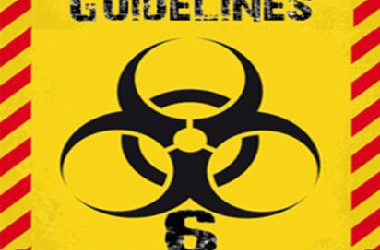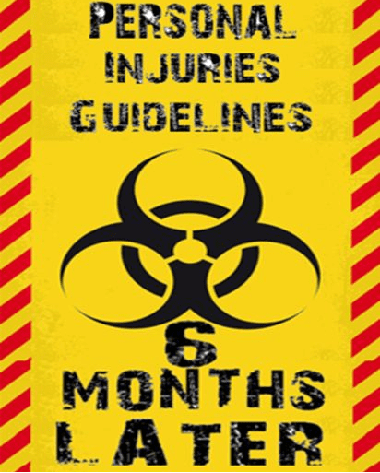The Personal Injuries Guidelines: 6 months later
November 2021
- Introduction
It is now over 6 months since the Personal Injuries Guidelines (“the Guidelines”) were commenced on 24 April 2021. The commencement of the Guidelines marked the culmination of a multi-year process of review, debate, consultation, and consideration as to the best and most appropriate means by which to seek to reduce and regularise the level of awards in personal injuries actions.
Whilst advocates for claimants expressed concern as to the level of reductions contained in the Guidelines – and scepticism as to the impact any reduction in the level of awards would have on premiums – policyholders, defendants and insurers alike welcomed their introduction. The Minister for Justice, Helen McEntee TD, heralded the Guidelines as taking into account both the urgency in tackling high insurance costs and fairness for those who have suffered injury as well as those who are required to defend a claim.
In this article we consider the early impact of the Guidelines as it relates to the level of awards and acceptance rates, the issues which have arisen in relation to their implementation, the anticipated attitude of the Courts to the Guidelines, and our views as to likely developments over the next year.
- The Numbers
Award Levels
The first indication as to the impact of the Guidelines on the level of awards in personal injuries matters was contained in PIAB’s 2020 Annual Report, published on 27 July 2021, in which it was disclosed that the 3-month period following the commencement of the Guidelines saw a 50% fall in the average value of awards[1].
The 2020 Annual Report was followed on 15 October 2021 by a report entitled ‘PIAB Personal Injuries Award Values April 24th – 30th September 2021’ (the “Award Values Report”), the purpose of which was to present up-to-date data on the three areas of liability covered by PIAB: motor, public and employer liability, and to give some insight into the impact of the new Guidelines on award levels.
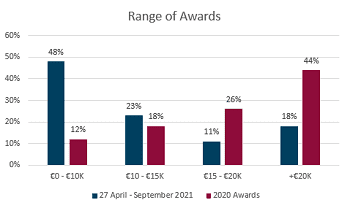 In this Report PIAB considered a total of 2,649 claims assessed by reference to the Guidelines over the period to 30 September 2021[2] and reported that average awards reduced by 40% from €23,877 (as per the 2020 average) to €14,233 (post-Guidelines). The largest single reduction was in respect of awards for Employer’s Liability (“EL”) claims which reduced by 44% from €30,576 (2020) to €17,203 (post-Guidelines). Awards for Motor Liability claims reduced by 40% from €22,158 (2020) to €13,230 (post-Guidelines), and awards for Public Liability (“PL”) claims also reduced by 40% from €26,000 (2020) to €15,697 (post-Guidelines).
In this Report PIAB considered a total of 2,649 claims assessed by reference to the Guidelines over the period to 30 September 2021[2] and reported that average awards reduced by 40% from €23,877 (as per the 2020 average) to €14,233 (post-Guidelines). The largest single reduction was in respect of awards for Employer’s Liability (“EL”) claims which reduced by 44% from €30,576 (2020) to €17,203 (post-Guidelines). Awards for Motor Liability claims reduced by 40% from €22,158 (2020) to €13,230 (post-Guidelines), and awards for Public Liability (“PL”) claims also reduced by 40% from €26,000 (2020) to €15,697 (post-Guidelines).
When special damages (to include loss of earnings and vouched expenses) are excluded, the average award level for general damages is reported as having reduced by c46% from €21,850 in 2020 to €11,808 in the post-Guidelines period.
Perhaps the starkest statistic in the Award Values Report was that almost half – 48% – of all awards made in the period since the commencement of the Guidelines were for under €10,000, compared to 12% in 2020 (i.e. under the previous Book of Quantum), with 18% of awards under €5,000 and 30% between €5,000 and €10,000. In addition, 71% of the awards made over the period were under €15,000 (compared to 30% in 2020). This is a particularly significant reference point as €15,000 represents the current jurisdiction of the District Court. By reference to the overall volume of claims and the percentage breakdown across the 3 categories, this is likely to be most reflected in a significant increase of Motor Claims litigated in the District Court.
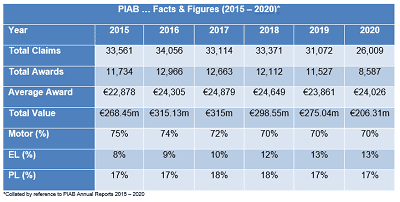
It is abundantly clear from even a cursory review of the statistics that the Guidelines have had the heralded effect of significantly reducing the level of PIAB Awards (to date at least) across the full gamut of claims. To consider the wider impact of these reductions, however, we also need to consider the attitude of claimants and respondents alike to the post-Guidelines PIAB Awards (reflected in the acceptance rates), and, perhaps most importantly, the various courts’ attitude and approach to the application of the Guidelines.
Acceptance Rates
In her ‘Chief Executive’s Review’ in PIAB’s 2020 Annual Report, Rosalind Carroll set out her view that the “advent of the Personal Injuries Guidelines is another hugely significant change that will impact this area and should also drive up acceptance rates for PIAB awards. At the heart of the introduction of the Guidelines is the objective of achieving consistency, transparency and certainty in personal injury awards across Ireland. This should build trust in the PIAB system”.
Subsequently, in the days leading up to the commencement of the Guidelines, it was reported that Ms Carroll, was of the belief that “acceptance rates for its awards will begin to shoot up once the long-awaited guidelines finally come into force” and it was her hope that “we get to see the acceptance rates climbing fairly quickly”[3].
It may well be that in time the acceptance rates for PIAB Awards will increase, but the initial data reflects the contrary position, with the combined acceptance rates for PIAB Awards (i.e. in respect of claims where both parties accepted the PIAB award) in respect of the post-Guidelines period falling sharply by almost 14% from an overall average of c51% in 2020 to an average of c37% (to the end of August 2021 – based on a total of 1,755 cases).
Whilst there has been a general downward trend in the combined acceptance rates of PIAB Awards over the last few years (from a high of 58% in 2015 steadily down to 51% in 2020 – albeit the average value of awards between 2016 and 2020 remained constant), the precipitous reduction to 37% in respect of the post-Guidelines period is an outlier and clearly a potentially significant issue.
It is interesting to also consider the breakdown of the combined acceptance rates across Motor, EL, and PL claims. The post-Guidelines acceptance rate for Motor claims is reported as decreasing by 15% from 49.2% in 2020 to 34.2% post-Guidelines. For EL claims it is 39.1%, compared with 56.1% in 2020 – i.e. a drop of 17%. And for PL claims it is 39.1%, compared with 53.9% – i.e. a drop of 14.8%. As with the consistency of the drop in the value of PIAB Awards across the 3 claim types, the level of decrease in the acceptance rate is similarly consistent across Motor, EL, and PL claims. This suggests at least that the application of the Guidelines to personal injuries claims is not adversely impacting one claim type over any other.

It is very clear from the information provided by PIAB that the downward pressure on the combined acceptance rate is being driven almost entirely from the claimant side (as the respondent acceptance rate is at 93.1%).
This decrease in the acceptance rate has recently been acknowledged by PIAB, with its Chief Executive admitting that, “despite significant progress on Awards, Guidelines and insurance reform, low acceptance rates of awards and consent rates remain a problem.” Ms Carroll believes that the Guidelines, “should ultimately improve acceptance rates” but has stressed that, “solicitors and insurers also have a key role to play by accepting awards that will not materially change in value through costly litigation.”
There is little or no mystery as to why the respondent acceptance rate is so high in respect of post-Guidelines PIAB Awards (93.1%). Although the acceptance rate is not a statistic which was previously published by PIAB in their Annual Reports, it is stated in the Awards Value Report that “traditionally respondents/insurers accept about 90% of awards”.
To the extent that this rate has increased in respect of post-Guidelines Awards – even if only modestly – a question which does arise is if there is now a cohort of claims which respondents/insurers would previously either not have consented to PIAB assessing or where they would have rejected any Award made, but where a contrary view is now being taken only because of the perceived low level of the PIAB Award, and regardless of views as to liability or other considerations. Insurers may find themselves in difficulty in due course if this does become a common practice, particularly when regard is had to their claims handling duties under S.16 of the Consumer Insurance Contracts Act (2019), which provides at sub-section 4 (d) that without prejudice … to an insurer’s right to make the final determination in relation to a claim, the insurer shall be under a duty to … where a claim has been settled or otherwise disposed of, inform the consumer of the amount for which it has been settled or otherwise disposed of and the reason or reasons for its being settled or so disposed of (our underline). That a claim has been settled only because it was ‘cheaper’ to do so rather than to defend it (and in so doing vindicate a policyholder’s position) may not be considered a good enough reason.
The more significant question which arises in relation to the acceptance rates – at least as it pertains to the long-term efficacy of the Guidelines – is why are claimants rejecting post-Guidelines PIAB Awards in such significant numbers? Clearly the answer would seem to lie in the fact that the Award levels have reduced by so much that a significant cohort of claimants either feel – or are being advised – that the Award is ‘too low’, and they are prepared to ‘take their chances’ by rejecting the Award and proceeding to litigation, either expecting to do better in court or, more likely, anticipating a settlement offer from insurers.
To that end, it has been our anecdotal experience from discussions with claimant solicitors that there is a view that PIAB have, on occasion at least, adopted too heavy-handed an approach to their assessment of a claimant’s injuries, or used ‘too sharp a pencil’ in deciding the category and bracket into which a particular injury should fall (leaning in many instances to the lower brackets), with then little or no ‘uplift’ in respect of any other less significant injuries. Indeed this view was expressed by Stuart Gilhooly SC at the Law Society Litigation Conference on 4 November 2021 where he stated that PIAB is “going about this the wrong way,” because they give awards that are far too low …” [4].
It is our view, however, that the main issue which underpins both claimants’ and respondents’ attitudes alike to Awards and the decision to accept or reject is confidence in the accuracy of the Award and the likelihood of the Award being ‘beaten’ at hearing.
It cannot be forgotten that the Guidelines are a construct of the judiciary, and it is for that reason that it will not be until we begin to see determinations from the various courts as to the correct application of the Guidelines and the appropriate level of awards in respect of various injuries, that we can make any informed conclusions as to the likely future trend of acceptance rates. In the short term, however, it is to be expected that the combined acceptance rate for PIAB Awards will remain at a depressed level, at least until a cohort of ‘Guidelines cases’ have been ruled in court, as only then will claimants and respondents be in a position to start to ‘trust’ and, as a result, accept (or reject) the Assessments made by PIAB.
For the time being, however, the more detailed data which can be made available the better, and PIAB is to be commended for producing the interim Award Values Report as quickly as it did, and for providing in it a more detailed breakdown of the Awards and acceptance rates than has previously been the case. It is information which will continue to inform all interested parties’ views not only in individual cases, and whether to accept or reject an award, but also on a wider basis in respect of the viability of Ireland as a place for insurers to profitably write liability business.
- The Courts
Decisions
Given the relatively short period of time which has elapsed since their commencement there have not, to date, been any specific determinations or decisions in relation to quantum by reference to
the Guidelines by any Court of which we are aware. It is to be expected, however, that cases in which the Guidelines apply will start to come before the Courts before the end of the current legal year. Any such decisions will be closely scrutinised, not just in relation to the level of awards, but also the attitude, rationale, and approach of the various judges and Courts and any reasons given for departing from the Guidelines. To that end, it should be recalled that the introduction of the Guidelines was not unanimously supported within the judiciary, with the Guidelines only taking effect upon a slim majority vote of the Judicial Council of 83 to 63.
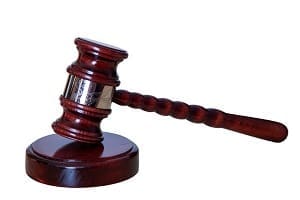
Indeed, it was reported at the time that such high-profile judges as Mr Justice Kevin Cross and Mr Justice Anthony Barr spoke against adopting the Guidelines. Justice Cross also stressed that the Guidelines “do not change the law”. Judges are still required to assess damages that are “fair and reasonable” in individual cases and if a judge believes it is necessary to depart from the guidelines to do so, all that judge needs to do is give their reasons for doing so, he said.[5]”
Whilst we are not aware of any case in which the issue of quantum has been decided by reference to them, the Guidelines have nonetheless been considered or referenced in one recent High Court case and one Court of Appeal decision and it is interesting to have regard to these in seeking to ascertain the likely attitude of those Courts going forward.
In our March 2021 Article – ‘Personal Injuries Guidelines: Update re Implementation and Application’ – we noted that despite the changes introduced following the commencement of S.99 of the Judicial Council Act, 2019, S.22(2) of the Civil Liability and Courts Act, 2004 was left unchanged. S.22 (1) of the 2004 Act requires that the court shall, in assessing damages in a personal injuries action, have regard to the Book of Quantum. S.22(2), however, provides that Subsection (1) shall not operate to prohibit a court from having regard to matters other than the Book of Quantum when assessing damages in a personal injuries action (our underline).
It was our view that amongst such ‘matters other than the Book of Quantum’ will be historical case law and precedent – which will continue to be important and relevant in any event in relation to the assessment of damages in ‘new’ claims, particularly claims falling into the higher (and wider) upper brackets of the Guidelines. It is also quite possible, however, that another such matter to which regard may be had could in fact be the Guidelines themselves. There does not seem to be any specific reason as to why they could not be referenced in respect of older claims.
In his much publicised decision in the joint matters of O’Mahoney v Tipperary County Council & Ors and Kennedy v Tipperary County Council & Ors [2021] IEHC 643 Mr Justice Twomey appeared to concur with this assessment when, acknowledging that as the case in question was instituted prior to 24 April 2021 the Guidelines are not binding on the Court, he nonetheless stated that:
“… it remains to be observed that there is no reason why, in appropriate cases, an Irish court cannot, if it so wishes, refer to the Personal Injury Guidelines to assist it in reaching its assessment of damages, even though the Personal Injury Guidelines are not ‘binding’ on the court (in relation to litigation commenced prior to 24th April, 2021). (In this regard, s. 22(2) of the Civil Liability and Courts Act 2004 states that subsection (1) (cited above) ‘shall not operate to prohibit a court from having regard to matters other than the Book of Quantum when assessing damages in a personal injuries action’).”
Our emphasis
He went on to reiterate the point in stating:
“It is difficult to see therefore why an Irish court could not, if it so wished, rely on other non-binding guidelines (in this case the Personal Injury Guidelines issued by the Judicial Council in Ireland), even if those Guidelines are not binding on the court (if the litigation was commenced prior to 24th April, 2021), in order to assist the court, if it felt it needed assistance, in reaching its conclusion as to the reasonableness of a certain figure for damages.”
It does have to be noted though that the contrary position was espoused by the Court of Appeal in the decision of Ms Justice O’Flaherty (with whom Justices’ Whelan and Collins agreed) in the matter of Quinn v Masivlaniec & Stanczk [2021] IECA 247. In that case, which related to an accident which occurred in 2013, no reference was made to S.22 of the 2004 Act – which may suggest that it simply wasn’t considered in that instance – but rather Justice O’Flaherty noted:
“It is of course the case that the Book of Quantum has now been replaced by the Personal Injuries Guidelines issued pursuant to s. 90 of the Judicial Council Act 2019. These Guidelines have the same objective as the Book of Quantum, that is to promote consistency in the level of damages awarded for personal injuries (s.90(3)(d)). However, the focus of this Court will be on the Book of Quantum, where appropriate, being the relevant guidelines for present purposes.”
Any question as to the potential retrospective application of the Guidelines – at least as a factor – in relation to the determination of quantum in pre-Guidelines cases will of course be an important one to have addressed. The more pressing, and likely less-controversial application of the Guidelines themselves to post 24 April 2021 claims should begin to be addressed by the courts at all levels over the coming months.
The District Court
An immediate and obvious issue which flows from the fact that over 70% of post-Guidelines awards were for €15,000 or less – particularly when coupled with the significant decrease in the combined acceptance rate – is the likely influx of personal injuries litigation into the District Court. Although there will of course be a cohort of these claims which are still issued in the Circuit Court (reflective of an individual Claimant’s view that the PIAB Award was too low), it is to be expected that a significant percentage will now issue in the District Court. If this does indeed come to pass it will represent an almost complete reversal of the traditional breakdown of personal injuries cases across the three Courts of first instance – i.e. the District Court, Circuit Court and High Court, with an average of only c5% of all personal injuries actions commenced in the District Court over the period 2017 – 2020[6].
One of the potentially negative unintended (although not unpredicted) consequences of this likely sea-change in the distribution of personal injuries litigation arises from the District Court’s capacity to deal with these claims in a timely manner. The District Court is already over-burdened as it is and, as was pointed out by the then President of the Law Society “a concerning effect of the new guidelines [will be] reduced access to justice for many injured people who will appear before an already overburdened District Court and Circuit Court, ill-equipped to handle the increase in cases. These courts cannot allocate the necessary time to have injured people’s cases heard. This added pressure on those courts will require more judges, staff and courtrooms to resolve. Failing that, the inevitable result will be huge delays. Justice delayed is justice denied.”[7]
Leaving aside the capacity of the District Court to deal with an increase in personal injuries litigation, there are also very real concerns – perhaps particularly on the defendant side – as to practice and procedure issues in that jurisdiction. Despite being the ‘lowest’ court, it is perhaps the most complicated and onerous from a defence perspective.
There is also the issue of costs in the District Court. At present, solicitors’ costs in the District Court are calculated by reference to a scale of fees (subject to the level of settlement), which fees are at a markedly lower level than is ordinarily recovered in respect of Circuit Court cases. The point has been made by solicitors acting for claimants that it may become uneconomic for them to litigate certain types of claims, thus reducing a claimant’s access to justice, and potentially increasing the number of lay litigants. Conversely, as suggested above, the same claims may be considered by insurers as ‘uneconomic’ to defend, notwithstanding that there may be a valid defence to the claim.
The answers to the difficulties presented by increased personal injuries litigation in the District Court likely lie in reform of the rules and, more pertinently, an increase in the number of judges. But as Ireland has amongst the lowest number of judges per capita in the EU (and has done for decades) it is not clear if there is the political will to address this need.
Constitutional Challenges
In its report ‘Capping damages in personal injuries actions’ as part of the Fifth Programme of Law Reform, the Law Reform Commission concluded that caps imposed by the (then proposed) Guidelines will likely resist any constitutional challenge and that the Guidelines will meet constitutional tests of proportionality. Particular emphasis was placed on the fact that judges are not
bound by the Guidelines, rather, whilst they must have regard to them, they are permitted to depart from the Guidelines in any case (subject to giving their reasons for doing so).
Notwithstanding the LRC Report, however, we are aware of 9 Judicial Review proceedings (and one plenary summons) which have been issued in the High Court against PIAB and/or the Judicial Council since the commencement of the Guidelines[8]. Although these matters have yet to be litigated it is understood that in at least 5 of these cases the applicants are challenging the constitutionality of the laws underpinning the Guidelines, with other cases understood to challenge the timing of the PIAB Award[9]. It is expected that further similar proceedings will issue over the coming weeks and months.
It is reported that the applicants in the Judicial Review proceedings claim the application of the guidelines breaches the separation of powers between the legislature and the judiciary and their constitutional rights to bodily integrity, property and equality. It is also claimed the relevant laws are incompatible with the fair trial right provisions of the European Convention on Human Rights[10]. It is further reported that the applicants’ arguments include that the guidelines effectively amount to judge-made law, rather than legislation promulgated by the Oireachtas, in breach of the separation of powers.
An issue which immediately arises in relation to the hearing of these applications is the fact that as almost all judges participated in the Judicial Council’s vote on the guidelines in March 2021, the challenges will likely need to be heard by a judge or judges from the more recently appointed High Court judges not involved in the vote.
Whatever the outcome of any High Court hearing, however, it is inevitable that any decision will be appealed – most likely to the Supreme Court given the constitutional issues – which in turn gives rise to an issue as to the make up of any Court hearing an appeal as most (if not all) of both the Supreme Court and Court of Appeal voted on the Guidelines.
As with the need for a series of decisions in relation to the operation and application of the Guidelines themselves in relation to the assessment of quantum, it will clearly be similarly important that any doubts or questions in relation to the constitutionality of the Guidelines are also resolved as soon as possible, so as to avoid a scenario where a significant volume of personal injuries claims are effectively ‘stayed’ pending confirmation that the Guidelines are in fact constitutional.
- Commentary / Conclusions
More so than most common law jurisdictions the issue of personal injuries claims has an extremely high profile in Ireland and it is very much in the public consciousness. Reports of personal injuries cases fill column inches in daily papers and are reported across all media. Indeed, PIAB itself is currently running a national radio advertisement with the tagline ‘Get Better Soon’ and promising Similar compensation, faster resolution, fairer for all. It is because of that high profile that there is a similarly high public ‘awareness’ as to the existence of the Guidelines and the fact that they have been designed to reduce the level of awards across all categories of personal injuries claims. There is an expectation on the part of both claimants and respondents in the post-Guidelines era, therefore, that the sum awarded in respect of general damages for any given claim will likely be significantly lower than was previously the case.
The question remains, however, as to what is the ‘correct’ level of award in respect of various injuries. By reference to the marked reduction in the claimant acceptance rates for PIAB Awards it would appear that for the time being at least there is a view that the PIAB Awards may be too low. In reality this view is more a product of uncertainty then it is necessarily a criticism of PIAB. It may well be that the PIAB Awards will in time be determined as accurate applications of the Guidelines and, as a result, acceptance rates will once again rise.
To get to that position, however, and for all interested parties to benefit (which most importantly from a wider societal perspective includes SME’s), it is critical that we begin to see judgments from the Courts with awards based exclusively on the Guidelines as soon as possible. It is to be expected that a review of these decisions, and in particular the approach taken by the various courts in determining the correct category and ‘band’ of injury and the level of awards as a result, will assist claimants and respondents alike in assessing the merits of accepting or rejecting the PIAB Award. It will perhaps be an equally important part of that determination that the parties involved also begin to understand the reasons given by judges from departing from the Guidelines. It may also be the case that in time more judges will concur with the view of Justice Twomey as to the potential retrospective application of the Guidelines to pre-Guidelines litigation, which in turn could have a levelling effect across all existing personal injuries claims, both pre- and post-Guidelines.
In order to obtain the benefit of court judgments, respondents – specifically insurers – will have to (in the short to medium term at least) resist the traditional temptation to settle almost all claims. Rather, in respect of those claims where insurers have accepted a PIAB Award because they were of the view that it represented the correct application of the Guidelines (as opposed to a strategic view that it represented a ‘good’ or ‘commercial’ settlement), there will be an onus on insurers in such cases to rely on the PIAB Award alone (and the costs protection afforded by S.51A of the PIAB Act, 2007) and to seek to fast track any litigation to hearing in order to have the issue of quantum determined.
There will clearly be a need for insurers as a group to adopt a ‘macro’ as opposed to a ‘transactional’ approach. In particular, insurers will need to resist what has long been proven to be the insidious and ultimately counter-productive practice of ‘topping up’ PIAB Awards in order to settle claims pre-hearing – in what we suggest would in the long-term transpire to be the mistaken belief that they are still ‘saving’. The history of high awards (or perhaps more accurately high settlements) in this jurisdiction was as much an insurer generated problem as it was the fault of claimants. Lessons need to be learned as to the long-term impact of settling claims for the sake of settlement.
There will, of course, be claims in which the Courts make an award greater than the PIAB Award. And there will be costs implications for insurers in those cases (albeit that those costs can be kept to a minimum by careful case management). The longer-term benefit of the wider impact and clarification on award levels which such decisions will have, however, clearly mitigates against the short term ‘hit’ in individual cases.
A lengthy history of high awards and the over-settlement of personal injuries claims – as well as the over eagerness to settle claims regardless of liability – coupled with issues in relation to costs and other factors such as delays in litigation and latterly Brexit, has ultimately led to the flight of all but a few non-domestic insurers from Irish liability insurance[11], and a diminished appetite on the part of the domestic market. As a result, insurance premiums have steadily increased over the last few years to the point now where they are simply unsustainable for many businesses. The Guidelines represent the most significant and concrete effort to address the ‘damages’ aspect of this equation. They are an extremely important step in the right direction, but they cannot be the solution to all ills.
The English philosopher Jeremy Bentham said that the power of the lawyer is in the uncertainty of the law. Subject, however, to the hoped-for certainty which will be brought to bear through judgments from the courts in early course, and the subsequent confidence which this should give to claimants and respondents in accepting or rejecting PIAB Awards, the hope is that the consistent and reliable application of the Guidelines and the consequent reduction in the level of general damages will play its part in once again making Ireland a more attractive market for insurers, increase competition, and reduce premiums, such that otherwise good, viable, and societally important businesses will no longer be forced to shut their doors for want of access to affordable – or indeed any – insurance.
[1] which analysis was based on a sample of 588 cases assessed to 18 June 2021
[2] comprising 1,795 Motor, 505 PL, and 349 EL claims
[3] Guidelines should see surge in the acceptance of PIAB awards
[4] https://www.lawsociety.ie/gazette/top-stories/2021/11-november/clients-distinctly-unimpressed-with-level-of-piab-awards–solicitor
[5] New guidelines on personal injury awards do not change the law, says judge – Irish Times, 22 April 2021
[6] For reference, of 22,417 personal injury claims issued in 2017 only 1,011 (4.5%) were in the District Court, 967 (4.3%) of 22,049 in 2018, 1,116 (5.1%) of 21,981 in 2019, and 1,045 (5.8%) of 17,810 in 2020.
[8] Lee [A Minor] – v – PIAB (2021) 387 JR; BONFIRRARO [A Minor] – v – PIAB (2021) 388 JR; Harris [A Minor] – v – PIAB (2021) 389 JR; Malone Walker [A Minor] – v – PIAB (2021) 388 JR; McCarthy [A Minor] – v – PIAB (2021) 388 JR; Delaney – v – PIAB, Judicial Council, Ireland & AG (2021) 641 JR; Wolfe – v – PIAB (2021) 712 JR; Calvin – v – PIAB, Ireland & AG (2021) 796 JR; Nevin – v – PIAB, Ireland & AG (2021) 820 JR; Zoran – v – Judicial Council, Ireland & AG (2021) 5173P
[9] Woman who fractured foot challenges new personal injury guidelines – Irish Times, 12 July 2021
[10] Judges face dilemma as personal injury awards guidelines are challenged – Irish Times, 8 November 2021
[11] ‘This crisis is just starting, hundreds of businesses are facing closure’ – warns insurance broker – Irish Independent, 29 October 2021.
Download PDF





